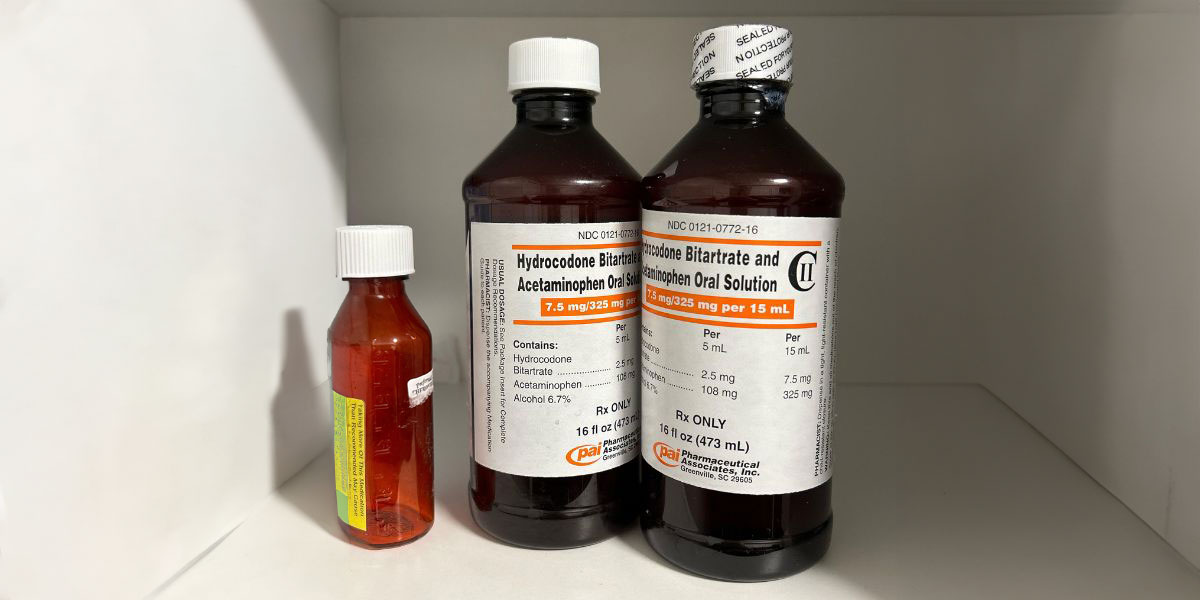Lortab (Hydrocodone and Acetaminophen) Addiction


Medical Writer:
Reviewer:

Johnny Kim
Executive Psychotherapist
Medical Writer:
Reviewer:

Johnny Kim
Executive Psychotherapist
In 2017, this pain medicine was the most frequently given out in the United States, with more than 83.6 million prescriptions. Highly effective at reducing pain, it can also be addictive and lead to dependency. That’s why it is prescribed carefully and regulated closely.
There are many brand names for products containing hydrocodone. The common ones combine hydrocodone and acetaminophen, known by popular brands like Vicodin and Lortab. These prescription medications are frequently utilized for managing moderate to severe pain.
Table of Contents
ToggleIn October 2014, the Drug Enforcement Administration (DEA) changed hydrocodone combination drugs from Schedule III to Schedule II due to worries about misuse. This adjustment was implemented to enforce stricter regulations and diminish the likelihood of hydrocodone addiction.
Substances with the highest risk of abuse and harm are classified as Schedule II drugs. Schedule I is designated for controlled substances that lack accepted medical use and have no confirmed safety profile.
What Is Lortab?
Lortab, a prescription drug, is used to relieve pain. Being a combination of hydrocodone and acetaminophen, it effectively addresses pain through two distinct medications.
Hydrocodone and acetaminophen work together to reduce pain by changing how the body feels pain signals to the brain. Doctors classify it as a narcotic analgesic or opioid analgesic, which is another term for pain relief medications.

Hydrocodone
Hydrocodone, a semi-synthetic opioid, has long been employed to manage both acute and chronic pain. It outperforms codeine as a cough suppressant and equals morphine in pain relief capabilities.
Reports of hydrocodone addiction have been documented since 1961. It is often misused for its opioid effects, which produce euphoria and lead to rapid physical dependency. Commonly, it is abused in conjunction with alcohol consumption.
In 2017, the AAPCC, or the American Association of Poison Control Centers, noted 1,810 cases of poisoning, and one death directly linked to hydrocodone was reported.
Acetaminophen
The acetaminophen in Lortab enhances its effectiveness and potency. It functions as a gentle to moderate analgesic and antipyretic.
Despite 60 million Americans regularly taking acetaminophen, many are unaware that it is a component in opioid combination medications. It is crucial to avoid taking other medicines containing acetaminophen and to discuss all your medications with your physician.
The stomach and intestines quickly absorb acetaminophen, which is then processed by the liver. Taking a lot of Lortab with acetaminophen for a long time can significantly raise the chance of getting liver disease.
Consuming more than 4 grams of acetaminophen per day is linked to fatal liver damage, known as fatal hepatic necrosis.
It is important not to drink alcohol while taking Lortab because it can increase the risk of liver damage.
What Is Lortab Elixir?
Lortab is no longer available in pill form and is now only offered as a prescription liquid known as Lortab elixir. However, other versions of hydrocodone and acetaminophen continue to be available in generic and other branded tablet forms.
Lortab elixir should be used with caution, similar to other opioids.
What Does Lortab Elixir Look Like?
The Lortab elixir is a syrup of yellow hue that tastes like a tropical punch. Each 15 mL comprises 7.5 mg of hydrocodone and 500 mg of acetaminophen. This drug is dispensed in one-pint bottles and is extremely habit-forming.
Side Effects of Lortab
Lortab can lead to various side effects, including:
- Dehydration in the mouth
- Abdominal discomfort
- Exhaustion or weariness
- Muscular discomfort or stiffness
- Tinnitus
- Painful, challenging, or regular urination
- Struggling to fall asleep or maintain sleep
- Inflammation in the legs, ankles, or feet
- Involuntary tremors in a part of the body
Hydrocodone and acetaminophen can potentially slow down or make you suddenly stop breathing, particularly in senior and older adults, especially during the first three days of taking the prescription pain medication and each time the dose is escalated.
Additional side effects of Lortab may include:
- Discomfort in the chest
- Upset stomach, vomiting, lack of hunger, or loose stools
- Fatigue or lightheadedness
- Restlessness or delusions, such as perceiving or hearing things that aren’t there
- High temperature
- Perspiration
- Bewilderment
- Fast pulse or alterations in heart rhythm
- Trembling
- Intense muscle rigidity or spasms
- Lack of balance
- Irregular periods
- Decreased libido
- Inflammation of the eyes, face, lips, tongue, or throat
- Raspy voice
- Skin rashes
- Runny nose
- Pruritus
- Trouble swallowing
If you are pregnant or planning to be, you must tell your doctor. Babies born to mothers who frequently use Lortab may experience withdrawal symptoms. Also, since hydrocodone and acetaminophen can be found in breast milk, there may be a risk to the baby when breastfeeding.
When you start a new treatment or refill your Lortab, your doctor or pharmacist will provide you with a medication guide. This guide contains important information about the medication.
It is important to read and understand the information in the guide. If you have any questions or concerns, be sure to ask your doctor or pharmacist for clarification. Call your doctor immediately if you encounter any abnormal or allergic responses while on Lortab.

Lortab Dangers
Lortab can lead to life-threatening respiratory depression, significantly slowing down breathing, which can cause the individual to slip into a coma or result in death.
The danger of taking Lortab escalates when consumed with other central nervous system (CNS) suppressants like benzodiazepines, alcohol, and muscle relaxers. Additionally, while using Lortab, dangerous drug interactions can occur with herbal products, especially St. John’s wort and tryptophan.
People who have suffered head trauma, have a brain neoplasm, or any situation that increases cranial pressure should avoid using Lortab, hydrocodone, or any other opioid-derived drugs.
Hydrocodone Overdose
Signs of a hydrocodone overdose include:
- Reduced or superficial respiration
- Trouble in breathing
- Weakness in muscles
- Skin that is cold and damp
- Pupils that are constricted or dilated
- Decreased heart rate
- Unresponsive or inability to awaken
If you experience any of these symptoms, immediately contact your physician or seek urgent medical assistance.
If you or someone you know is taking Lortab, it’s important to know how to recognize an overdose. It’s also important to understand how to use Narcan and follow the steps until help arrives.
If you take opioid medication, talk to your doctor about getting naloxone in case of emergency. This is especially important if you are frequently around someone who uses prescription drugs. Naloxone is successful in reversing the deadly consequences of opioid overdose.
Acetaminophen Overdose
Taking too much acetaminophen can lead to liver failure and is the second most common reason for liver transplants worldwide. The United States has the highest number of cases.
In the US, acetaminophen leads to 56,000 ER visits, 2,600 hospital stays, and 500 deaths annually. Half of these cases are accidental.
Symptoms of an acetaminophen overdose include:
- Feeling sick
- Throwing up
- Unusually high perspiration
- Skin that blisters or peels
- Yellowing of the skin and eye whites, also known as jaundice
- Intense stomach pain
- Low blood pressure, also referred to as hypotension
Acetaminophen is easy to get without a prescription and is generally safe. Still, it is important to monitor how much you are taking. Check the ingredients of all your medications to prevent harmful interactions and accidental overdose.
Lortab Addiction Treatment
Lortab is effective in relieving pain but can also lead to opioid addiction. Assistance is accessible if you or someone you love is battling opioid use disorder.
White Oak Recovery Center utilizes personalized, evidence-based treatment methods for substance use disorders. Our private residential facility offers a healing sanctuary amidst stunning landscapes and beautiful mountains.
Our caring environment provides medically supervised detox with around-the-clock medical care to ensure safety and comfort during withdrawal.
The team at WORC is committed and empathetic, handling each resident with honor and esteem. They understand that recovery is not just about achieving sobriety— it’s about beginning a new chapter in life.
Allow us to help heal the core of your addiction and guide you toward meaningful recovery. It all starts with a simple phone call. Reach out today.

Am I covered for addiction treatment?
Your insurance may cover treatment. Call now for an entirely free and confidential assessment. Recovery starts with a phone call.

- “Hydrocodone.” Drug Enforcement Administration, Oct. 2019.
- Habibi, Manuchehr, and Kim, Peggy Y., “Hydrocodone and Acetaminophen.” StatPearls: National Library of Medicine, Dec. 2022.
- “Hydrocodone.” MedlinePlus: National Library of Medicine, Mar. 2023.
- Cofano, Sean, et al., “Hydrocodone.” StatPearls: National Library of Medicine, Feb. 2024.
Medical Disclaimer:







